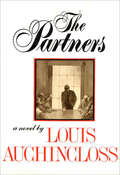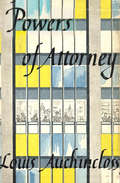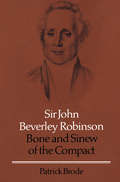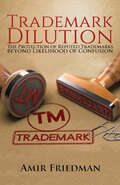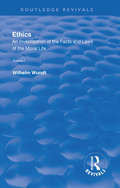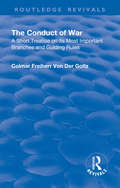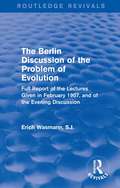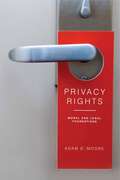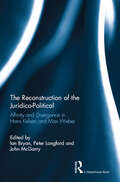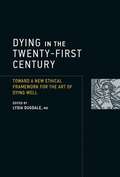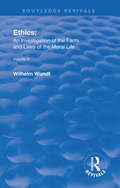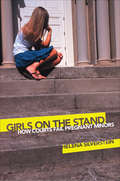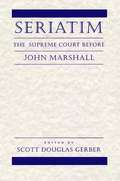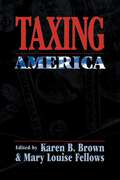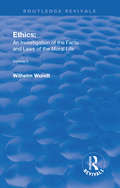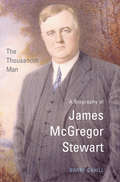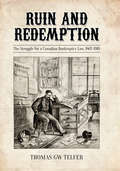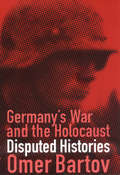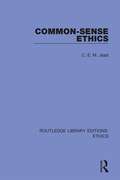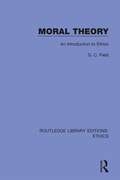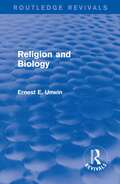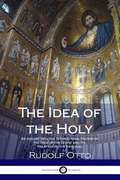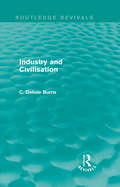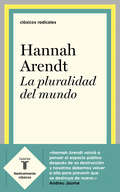- Table View
- List View
The Partners: A Novel
by Louis AuchinclossA New York Times–bestselling novel of love, money, and ambition among the employees of a white-shoe law firm. From a renowned chronicler of American high society, this is a novel set in the small but distinguished New York law firm of Shepard, Putney & Cox in the early 1970s. The son of a rich mother and a socially ambitious father, Beekman &“Beeky&” Ehninger makes a successful career for himself in the narrow upper echelons of his profession. For years, he has quietly guided his firm through numerous periods of transition—not to mention marital strife, forgery, and fraud. But as times have changed, Beeky and his colleagues must decide whether to join forces with a new and different breed—tough, but undeniably successful. The Partners is a masterful characterization of moral men navigating an amoral world, of lawyers, their families, and the rich and powerful people they serve. &“Vintage Auchincloss—sensitive, ironic, sympathetic, affecting. Auchincloss is particularly good with the interior reality of seemingly minor conflicts; he also shows, over and over again, that seemingly large and dramatic conflicts are often not the important ones.&” —New York magazine
Powers of Attorney
by Louis AuchinclossTales that take you behind the scenes of a powerful New York law firm, from the New York Times–bestselling author of The Partners. Ambition, jealousy, desire, hatred, deceit—they&’re all there inside the Wall Street law offices of Tower, Tilney & Webb, the setting for these interwoven stories set in the 1960s from Louis Auchincloss, who practiced law while also writing acclaimed and bestselling fiction. Senior partner Clitus Tilney is not about to let a detestable, hard-drinking partner make a mockery of all he&’s worked for. Harry Reilley is a clerk who pines for Tilney&’s daughter. Jake Platt is an associate willing to do whatever it takes to achieve his goals, including setting a rival up for failure. Rutherford Tower struggles with the fact that he owes his position with the firm to nepotism and not hard work. And then there&’s Mrs. Abercrombie, who&’s waiting for her sixty-fifth birthday, when she plans to retire—and get her revenge. These twelve linked stories capture the struggles, rivalries, victories, disappointments, and compromises in the day-to-day lives of lawyers, and a portrait of professional men and women in mid-century New York.
Sir John Beverley Robinson: Bone and Sinew of the Compact
by Patrick BrodeJohn Beverley Robinson (1791-1863) was one of Upper Canada's foremost jurists, a dominating influence on the ruling élite, and a leading citizen of nineteenth-century Toronto who owned a vast tract of land on which Osgoode Hall now stands. The loyalists had founded a colony firm in its devotion to the Crown, with little room for dissent. As a true loyalist son, educated by John Strachan, Robinson attempted to steer Upper Canada toward emulation of what he perceived to be Britain's ideal aristocratic society. As a young ensign in the York militia, he defended his sovereign at Queenston Heights, and as acting attorney-general he prosecuted traitors who threatened to undermine the colony. Later, as attorney-general and de facto leader of the assembly during the 1820s, he tried to mould the government to the British form. But factors he never understood--the influence of American democracy and liberalism in the Colonial Office--ensured that Upper Canada would never be a 'new Albion. ' Robinson was appointed chief justice in 1829, and his judicial career spanned thirty-three years, during which he insisted the courts were subservient to the legislature and established precedents declaring their role should be limited to the enforcement of existing laws, with no independent creative function. His long service on the bench represented both a preservation and a strengthening of the British tradition in Canadian law. In this biography, early Toronto comes alive through the eyes of a powerful man--firm in his beliefs, attractive to women, respected by his fellows--who sought to mould society to his own ideals. For historians, lawyers, and students of jurisprudence who seek an understanding of the roots of legal practice in nineteenth-century Ontario, it is essential reading.
Trademark Dilution: The Protection of Reputed Trademarks Beyond Likelihood of Confusion
by Amir FriedmanThe world has changed materially since the foundation of traditional trademark laws, according to which the purpose of a trademark was to serve as a differentiating source indicator, preventing source confusion in the marketplace. Traditionally, trademarks protected the public from likelihood of confusion, assisted in consumer decisions and reduced search costs. The need to award a special scope of protection to famous trademarks from use on non-competing goods was first discussed in Kodak in 1898, holding that the use of the word Kodak for a bicycle company does not mislead consumers but takes unfair advantage of reputation. However, the most significant point in the evolution of dilution, in its early stages, was the case of Odol decided in 1924, which was the first to acknowledge the need to protect the advertising power of trademarks from being diluted, even in the absence of a likelihood of confusion. This book will provide that dilution is a ‘sui generis’ brand remedy applicable to reputed trademarks in accordance to their aggregated inherent and acquired strength. The book will address the non-harmonised nature of dilution, which reflects a problem in an age of borderless trade and cyber commerce and emphasises the need to answer the question: To what extent should reputed trademarks be protected by dilution beyond the traditional trademark protection from likelihood of confusion? The book includes a proposal for an operative legal framework based on conclusions and distinctions derived from the comparison of dilution, as adopted and interpreted in different areas of the world, comparative case studies and comparison with neighbouring legal rights, such as Tort Law, Unfair Competition, Moral Rights, Equitable Rights, Publicity Rights and Unlawful Enrichment.
Revival: Volume I: Introduction: The Facts of Moral Life (Routledge Revivals)
by Wilhelm WundtIt has been my object in the present work to investigate the problems of ethics in the light of an examination of the facts of moral life. One reason for this procedure is my desire to conduct the reader by the same path that I myself have followed in approaching ethical questions.
Revival: A Short Treatise on its Most Importsant Branches and Guiding Rules (Routledge Revivals)
by Colmar Freiherr von de GoltzThis book contains, in a brief form, author’s views a to the conduct of the principal strategical and tactical operations of war, and will be found to be a short and convenient introduction to a deeper study of the rules which should underlie the direction of the ever-varying incidents of modern fighting.
The Berlin Discussion of the Problem of Evolution: Full Report of the Lectures Given in February 1907, and of the Evening Discussion
by Erich Wasmann, S.J.First published in 1909, this book collects the author’s lectures on the ‘problem of evolution’ and the resultant debate. The first considers the validity of the Theory of Evolution and whether it is in opposition to the Christian view of creation. The second examines the assertion that evolution harmonises only with Monism rather than Theism and which of the two views is preferable. It also looks at the popular identification of Darwinism with evolution, if it is scientific and the results this leads to. The third looks at man’s position in the problem of evolution — whether we are bound to bring in considerations higher than the zoological — and the evidence for our descent from ‘brutes’.
Privacy Rights: Moral and Legal Foundations
by Adam D. MooreWe all know that Google stores huge amounts of information about everyone who uses its search tools, that Amazon can recommend new books to us based on our past purchases, and that the U.S. government engaged in many data-mining activities during the Bush administration to acquire information about us, including involving telecommunications companies in monitoring our phone calls (currently the subject of a bill in Congress). Control over access to our bodies and to special places, like our homes, has traditionally been the focus of concerns about privacy, but access to information about us is raising new challenges for those anxious to protect our privacy. In Privacy Rights, Adam Moore adds informational privacy to physical and spatial privacy as fundamental to developing a general theory of privacy that is well grounded morally and legally.
The Reconstruction of the Juridico-Political: Affinity and Divergence in Hans Kelsen and Max Weber
by Peter Langford Ian Bryan John McGarryHans Kelsen and Max Weber are conventionally understood as the original proponents of two distinct and opposed processes of concept formation generating two separate and contrasting theoretical frameworks for the study of law. The Reconstruction of the Juridico-Political: Affinity and Divergence in Hans Kelsen and Max Weber contests the conventional understanding of the theoretical relationship between Kelsen’s legal positivism and Weber’s sociology of law. Utilising the conceptual frame of the juridico-political, the contributors to this interdisciplinary volume analyse central points of affinity and divergence in the work of these two influential figures. Thus, the chapters collected in The Reconstruction of the Juridico-Political offer a comprehensive reconsideration of these affinities and divergences, through a comparison of their respective reconstruction of the notions of democracy, the State, legal rights and the character of law. From this reconsideration a more complex understanding of their theoretical relationship emerges combined with a renewed emphasis upon the continued contemporary relevance of the work of Kelsen and Weber.
Dying in the Twenty-First Century
by Lydia DugdaleMost of us are generally ill-equipped for dying. Today, we neither see death nor prepare for it. But this has not always been the case. In the early fifteenth century, the Roman Catholic Church published the Ars moriendi texts, which established prayers and practices for an art of dying. In the twenty-first century, physicians rely on procedures and protocols for the efficient management of hospitalized patients. How can we recapture an art of dying that can facilitate our dying well? In this book, physicians, philosophers, and theologians attempt to articulate a bioethical framework for dying well in a secularized, diverse society. Contributors discuss such topics as the acceptance of human finitude; the role of hospice and palliative medicine; spiritual preparation for death; and the relationship between community, and individual autonomy. They also consider special cases, including children, elderly patients with dementia, and death in the early years of the AIDS epidemic, when doctors could do little more than accompany their patients in humble solidarity.These chapters make the case for a robust bioethics -- one that could foster both the contemplation of finitude and the cultivation of community that would be necessary for a contemporary art of dying well. ContributorsJeffrey P. Bishop, Lisa Sowle Cahill, Daniel Callahan, Farr A. Curlin, Lydia S. Dugdale, Michelle Harrington, John Lantos, Stephen R. Latham, M. Therese Lysaught, Autumn Alcott Ridenour, Peter A. Selwyn, Daniel Sulmasy
Revival: Volume III: The Principles of Morality and the Sphere of their Validity (Routledge Revivals)
by Wilhelm WundtIt has been my object in the present work to investigate the problems of ethics in the light of an examination of the facts of moral life. One reason for this procedure is my desire to conduct the reader by the same path that I myself have followed in approaching ethical questions.
Girls on the Stand: How Courts Fail Pregnant Minors
by Helena SilversteinChoice Outstanding Academic Title for 2008The U.S. Supreme Court has decided that states may require parental involvement in the abortion decisions of pregnant minors as long as minors have the opportunity to petition for a &#“bypass” of parental involvement. To date, virtually all of the 34 states that mandate parental involvement have put judges in charge of the bypass process. Individual judges are thereby responsible for deciding whether or not the minor has a legitimate basis to seek an abortion absent parental participation. In this revealing and disturbing book, Helena Silverstein presents a detailed picture of how the bypass process actually functions.Silverstein led a team of researchers who surveyed more than 200 courts designated to handle bypass cases in three states. Her research shows indisputably that laws are being routinely ignored and, when enforced, interpreted by judges in widely divergent ways. In fact, she finds audacious acts of judicial discretion, in which judges structure bypass proceedings in a shameless and calculated effort to communicate their religious and political views and to persuade minors to carry their pregnancies to term. Her investigations uncover judicial mandates that minors receive pro-life counseling from evangelical Christian ministries, as well as the practice of appointing attorneys to represent the interests of unborn children at bypass hearings.Girls on the Stand convincingly demonstrates that safeguards promised by parental involvement laws do not exist in practice and that a legal process designed to help young women make informed decisions instead victimizes them. In making this case, the book casts doubt not only on the structure of parental involvement mandates but also on the naïve faith in law that sustains them. It consciously contributes to a growing body of books aimed at debunking the popular myth that, in the land of the free, there is equal justice for all.
Holocaust Restitution
by Roger P. Alford Michael BazylerThe Holocaust was not only the greatest murder in history; it was also the greatest theft. Historians estimate that the Nazis stole roughly $230 billion to $320 billion in assets (figured in today’s dollars), from the Jews of Europe. Since the revelations concerning the wartime activities of the Swiss banks first broke in the late 1990s, an ever-widening circle of complicity and wrongdoing against Jews and other victims has emerged in the course of lawsuits waged by American lawyers. These suits involved German corporations, French and Austrian banks, European insurance companies, and double thefts of art—first by the Nazis, and then by museums and private collectors refusing to give them up. All of these injustices have come to light thanks to the American legal system. Holocaust Justice is the first book to tell the complete story of the legal campaign, conducted mainly on American soil, to address these injustices. Michael Bazyler, a legal scholar specializing in human rights and international law, takes an in-depth look at the series of lawsuits that gave rise to a coherent campaign to right historical wrongs. Diplomacy, individual pleas for justice by Holocaust survivors and various Jewish organizations for the last fifty years, and even suits in foreign courts, had not worked. It was only with the intervention of the American courts that elderly Holocaust survivors and millions of other wartime victims throughout the world were awarded compensation, and equally important, acknowledgment of the crimes committed against them. The unique features of the American system of justice—which allowed it to handle claims that originated over fifty years ago and in another part of the world—made it the only forum in the world where Holocaust claims could be heard. Without the lawsuits brought by American lawyers, Bazyler asserts, the claims of the elderly survivors and their heirs would continue to be ignored. For the first time in history, European and even American corporations are now being forced to pay restitution for war crimes totaling billions of dollars to Holocaust survivors and other victims. Bazyler deftly tells the unfolding stories: the Swiss banks’ attempt to hide dormant bank accounts belonging to Holocaust survivors or heirs of those who perished in the war; German private companies that used slave laborers during World War II—including American subsidiaries in Germany; Italian, Swiss and German insurance companies that refused to pay on prewar policies; and the legal wrangle going on today in American courts over art looted by the Nazis in wartime Europe. He describes both the human and legal dramas involved in the struggle for restitution, bringing the often-forgotten voices of Holocaust survivors to the forefront. He also addresses the controversial legal and moral issues over Holocaust restitution and the ethical debates over the distribution of funds. With an eye to the future, Bazyler discusses the enduring legacy of Holocaust restitution litigation, which is already being used as a model for obtaining justice for historical wrongs on both the domestic and international stage.
Seriatim: The Supreme Court Before John Marshall
by John MarshallSeldom has American law seen a more towering figure than Chief Justice John Marshall. Indeed, Marshall is almost universally regarded as the "father of the Supreme Court" and "the jurist who started it all." Yet even while acknowledging the indelible stamp Marshall put on the Supreme Court, it is possible--in fact necessary--to examine the pre-Marshall Court, and its justices, to gain a true understanding of the origins of American constitutionalism. The ten essays in this tightly edited volume were especially commissioned for the book, each by the leading authority on his or her particular subject. They examine such influential justices as John Jay, John Rutledge, William Cushing, James Wilson, John Blair, James Iredell, William Paterson, Samuel Chase, Oliver Ellsworth, and Bushrod Washington. The result is a fascinating window onto the origins of the most powerful court in the world, and on American constitutionalism itself.
Taxing America (Critical America #44)
by Mary Louise Fellows Karen B. BrownIn the winter of 1996, Steve Forbes--publisher, heir, and presidential candidate--captured the American imagination with his proposal for a flat tax. But while Mr. Forbes claimed that such a tax would level the economic playing field by eliminating countless loopholes and miles of red tape, his actual proposal betrayed such claims to fairness by overtaxing workers and undertaxing financial capital. In the face of recent proposals for dramatic and far-reaching tax reform, Taxing America takes a critical look at the way the federal government collects its revenue and exposes the bias at the heart of a system which claims to be objective and fair. Contrary to traditional tax scholarship, these writers argue that an awareness of disability discrimination, economic exploitation, heterosexism, sexism and racism is crucial to any analysis of tax policy. Gathering together essays whose topics range from federal housing policy to environmental clean-up costs to tax treaty policy making, Karen B. Brown and Mary Louise Fellows present a philosophy that is as simple as it is radical: economic arrangements contribute significantly to the creation of social hierarchies and the perpetuation of discrimination. Given this reality, Brown and Fellows maintain that the goal of the federal tax law should be social justice and the disruption of discriminatory and exploitative practices.
Revival: Volume II: Ethical Systems (Routledge Revivals)
by Wilhelm WundtThe present work aims to investigate the problems of ethics in the light of an examination of the facts of moral life.
The Thousandth Man
by Barry CahillJames McGregor Stewart (1889-1955) was perhaps the foremost Canadian corporate lawyer of his day. He was also an appellate counsel, venture capitalist, Conservative Party fundraiser, bibliographer of Rudyard Kipling, and sometime university teacher of classics. A leader of the bar in the inter-war period, he was the first Maritimer to serve as president of the Canadian Bar Association. He distinguished himself mainly in constitutional cases before the Judicial Committee of the Privy Council. During his career, Stewart was also head of the leading law firm in eastern Canada (now Stewart McKelvey Stirling Scales), director and vice-president of the Royal Bank of Canada, and senior counsel to the Royal Commission on Dominion-Provincial Relations.Above all, Stewart was committed to the idea of law as a truly learned profession and to the bar as the most important legal institution. To this day, no lawyer has held such prestige and power both within and outside Atlantic Canada; in his time he was the only Maritime lawyer who gained full acceptance by every branch of the Canadian establishment.Thematic rather that chronological in approach, this fascinating legal biography provides both a history of a uniquely Canadian career and an interpretation of its significance for Stewart's time and ours.
Ruin and Redemption
by Thomas G. TelferIn 1880 the federal Parliament of Canada repealed the Insolvent Act of 1875, leaving debtor-creditor matters to be regulated by the provinces. Almost forty years later, Parliament finally passed new bankruptcy legislation, recognizing that what was once considered a moral evil had become a commercial necessity. In Ruin and Redemption, Thomas G.W. Telfer analyses the ideas, interests, and institutions that shaped the evolution of Canadian bankruptcy law in this era. Examining the vigorous public debates over the idea of bankruptcy, Telfer argues that the law was shaped by conflict over the morality of release from debts and by the divergence of interests between local and distant creditors. Ruin and Redemption is the first full-length study of the origins of Canadian bankruptcy law, thus making it an important contribution to the study of Canada's commercial law.
Germany's War and the Holocaust: Disputed Histories
by Omer BartovWhile attempts to come to terms with past catastrophe . . . can help prevent its recurrence, they may also provide arguments for . . . actions against the real or imagined perpetrators of previous disasters. The confrontation with . . . catastrophe can help us understand the roots and nature of this century's destructive urges, as well as humanity's extraordinary recuperative capacities; but it can also legitimize the perpetuation of violence and aggression. -from the Introduction Omer Bartov, a leading scholar of the Wehrmacht and the Holocaust, provides a critical analysis of various recent ways to understand the genocidal policies of the Nazi regime and the reconstruction of German and Jewish identities in the wake of World War II. Germany's War and the Holocaust both deepens our understanding of a crucial period in history and serves as an invaluable introduction to the vast body of literature in the field of Holocaust studies. Drawing on his background as a military historian to probe the nature of German warfare, Bartov considers the postwar myth of army resistance to Hitler and investigates the image of Blitzkrieg as a means to glorify war, debilitate the enemy, and hide the realities of mass destruction. The author also addresses several new analyses of the roots and nature of Nazi extermination policies, including revisionist views of the concentration camps. Finally, Bartov examines some paradigmatic interpretations of the Nazi period and its aftermath: the changing American, European, and Israeli discourses on the Holocaust; Victor Klemperer's view of Nazi Germany from within; and Germany's perception of its own victimhood.
Common-Sense Ethics
by C. E. JoadOriginally published in 1921, this book makes philosophical ethics accessible to the non-philosopher and applies them to problems of everyday life. The author maintains that morality is the rationalization of the impulse to blame and emphases the importance of impulses. He illustrates how modern society conspires to suppress impulses and restrict their operation.
Moral Theory: An Introduction to Ethics
by G. C. FieldOriginally published in 1921, updated in 1932 and re-issued in 1966 with an introduction by Stephan Körner, this book remains a classic introduction to the study of ethics. It clearly explains both the Aristotelian and the Kantian approach to ethical problems, by combining the advantages of a historical and systematic introduction. Much of the book is devoted to Aristotle and Kant, whose moral theories are important and who are influential forces in contemporary moral philosophy.
Religion and Biology
by Ernest E. UnwinFirst published in 1922, this book represents an attempt to outline the biological approach to the questions of religious thought. The author posits the book as a contribution to religious thought in relation to the purpose of God in Nature, providing readers with an overview of the advances and changes in thought that had occurred in the years before the book was written. The examinations of the nature of man and of evolution in relation to religion make up the bulk of the book along with a look at the argument from beauty. The book will be of interest to students of religion, biology and philosophy.
The Idea of the Holy: An Inquiry into the Non-Rational Factor in the Idea of the Divine and Its Relation to the Rational
by Rudolf Otto John HarveyRudolf Otto's classic The Idea of the Holy brims with deep theological and philosophical insights into the theory of religion and spiritual belief in God. As both a theologian and a philosopher, Otto was fascinated by how the rational and non-rational interact and interplay with regard to humanity's religious beliefs. This investigation determines that valid, non-rational experiences are as poignant in the development of knowledge - yet how do we quantify and apportion value to various rational arguments for faith, and the experiences so many believers have had over the millennia? <p> The author delves into these arguments, and valiantly attempts to determine how the divine interacts with various emotions. He coins the term 'numinous' from the root word 'numen', to denote an emotional state of consciousness apt to receive spiritual insight. The many emotions and attuning of the soul to God falls under the designation, and it proved to be one of the most important ideas Otto would ever advance. <p> The Idea of the Holy remains an important text for students of both philosophy and religion, as well as spiritually inclined readers. Although Christian believers will profit from its concepts and deep discussion of spiritual matters, those of a different faith or of none often come to respect the intricacy and depth with which Otto explains and qualifies his theology in rational and non-rational terms. This edition contains the text of the original first translation to English of 1923 by John W. Harvey, who strived to preserve the clarity, concision and poise of Otto's lessons. Since the book was originally published in German in 1918, it has been translated into over twenty different languages.
Industry and Civilisation (Routledge Revivals)
by C. Delisle BurnsOriginally published in 1925, Industry and Civilisation explores moral standards and ethics related to economic activities by providing a comprehensive view of psychological data obtained from the business world. As well as exploring general ethics and psychology, this work also focusses on the principles underlying economic legislation and how this impacted on moral standards of the time. This title will be of interest to students of Business and Economics.
La pluralidad del mundo
by Hannah ArendtLa obra de Hannah Arendt sintetizada en esta antología esencial e imprescindible. No hay nada más radical que un clásico. Hannah Arendt, la gran pensadora del siglo XX, es sin duda fundamental para afrontar los desafíos del XXI. Abordó todas las cuestiones clave de su tiempo, desde el antisemitismo hasta el totalitarismo, los orígenes de la democracia, la crisis de la autoridad, los fundamentos de la educación y la estética o el problema del mal en la modernidad. Toda su obra está sintetizada en esta antología esencial e imprescindible. ------------- radical: adj. Perteneciente o relativo a la raíz. «Clásicos Radicales» nace con la misión de recuperar algunos de los libros más emblemáticos del sello que en su día formularon una idea nueva u ofrecieron una mirada original y pertinente sobre las grandes cuestiones universales.Ausentes de las librerías durante demasiado tiempo pero recordados y buscados por los lectores más despiertos, estos textos esenciales de disciplinas como la filosofía, la ética, la historia, la sociología, la economía, la antropología, la psicología y la política mantienen su plena vigencia y vuelven hoy con fuerza para iluminar nuestro presente. ------------- Reseña:«Hannah Arendt volvió a pensar el espacio público después de su destrucción y nosotros debemos volver a ella para prevenir que se destruya de nuevo.»Andreu Jaume
